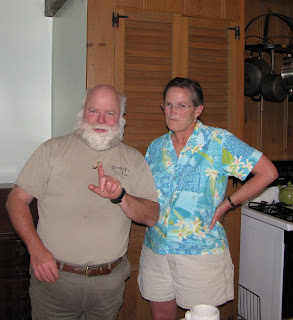Besides the human and canine residents at 24 Sugarloaf Street, our house is also occupied by a variety of arthropods, mostly spiders. Crystalyn says she is not fond of spiders, so I’m hoping she doesn’t read my blog, at least for the sake of the health of these arachnids living with us.
The first spider to meet my acquaintance was this very gravid (egg-laden) female “prowling spider” of the family Miturgidae, on the ceiling of the bathroom.  She is most likely a member of the genus Cheiracanthium, known also as “longlegged sac spiders.” The genus used to be in the family Clubionidae, but was moved to the Miturgidae in 1997, a decision still being debated in arachnological circles.
She is most likely a member of the genus Cheiracanthium, known also as “longlegged sac spiders.” The genus used to be in the family Clubionidae, but was moved to the Miturgidae in 1997, a decision still being debated in arachnological circles.
These spiders are mostly nocturnal, prowling during the night then spinning silken retreats in which they spend the day. This girl spun a bivouac as I watched.

Later I would find her mate in the kitchen.  Well, it was an adult male at least, evidenced by the modified palps. They appear as the dark “boxing gloves” near his mouth. The palps (or pedipalps) are leg-like mouthparts that double in the male as intromittent sex organs. He deposits sperm on a mat of webbing, then draws it into each palp. These are complex appendages, designed to fit like a key in a lock, the lock in this case being the female’s sex organ called the epigynium. Like the female, the male also “sacks out” during the day.
Well, it was an adult male at least, evidenced by the modified palps. They appear as the dark “boxing gloves” near his mouth. The palps (or pedipalps) are leg-like mouthparts that double in the male as intromittent sex organs. He deposits sperm on a mat of webbing, then draws it into each palp. These are complex appendages, designed to fit like a key in a lock, the lock in this case being the female’s sex organ called the epigynium. Like the female, the male also “sacks out” during the day.
Cheiracanthium had long been considered a genus of spiders at least mildly venomous to humans, but research has proven that this is a myth. So, I let them roam and carry out pest control activities. We definitely have too many mosquitoes here!
Crane flies of the family Tipulidae are very abundant now, some species being attracted to lights at night, and inevitably one strays indoors. This one has patterned wings.  It is on the bathroom ceiling, too, but I don’t know whether one of the spiders got it. Crane flies are often mistaken for giant mosquitoes, or are referred to as “mosquito hawks,” but the adult insects probably do not feed, let alone take prey. Their size is deceptive as they are fragile insects. Look at one cockeyed and a leg will fall off. Their lifespan as winged insects is brief, just long enough to find a mate and reproduce. Crane fly larvae live in an incredibly variety of habitats, with diets that vary with the genus to which they belong.
It is on the bathroom ceiling, too, but I don’t know whether one of the spiders got it. Crane flies are often mistaken for giant mosquitoes, or are referred to as “mosquito hawks,” but the adult insects probably do not feed, let alone take prey. Their size is deceptive as they are fragile insects. Look at one cockeyed and a leg will fall off. Their lifespan as winged insects is brief, just long enough to find a mate and reproduce. Crane fly larvae live in an incredibly variety of habitats, with diets that vary with the genus to which they belong.
A more permanent guest is yet another spider. This is what I imagine is a juvenile long-bodied cellar spider, Pholcus phalangioides, because adults are much larger.  This one is well on its way, though, especially if it continues catching prey in the bathroom doorjamb like this. Cellar spiders are totally harmless to people and pets. While they do build tangled webs, they will also stray from those webs into the webs of other spiders and kill and devour them. Pholcids are frequently referred to as “daddy longlegs,” but that colloquial name is also given to harvestmen, arachnids of the order Opiliones (not spiders), and, ironically, to crane flies, especially in England. A crane fly would be more than this little one could handle.
This one is well on its way, though, especially if it continues catching prey in the bathroom doorjamb like this. Cellar spiders are totally harmless to people and pets. While they do build tangled webs, they will also stray from those webs into the webs of other spiders and kill and devour them. Pholcids are frequently referred to as “daddy longlegs,” but that colloquial name is also given to harvestmen, arachnids of the order Opiliones (not spiders), and, ironically, to crane flies, especially in England. A crane fly would be more than this little one could handle.
Crystalyn is so busy that she sometimes forgets to turn the oven off, let alone observe the room for roaming arachnids. Her dog Ruby did see one, once, in the dining room, and drew our collective attention to it as it crossed the ceiling out of reach.






















